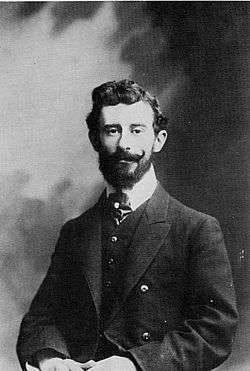Miroirs
Miroirs (French for "Mirrors") is a five-movement suite for solo piano written by French composer Maurice Ravel between 1904 and 1905.[1] First performed by Ricardo Viñes in 1906, Miroirs contains five movements, each dedicated to a fellow member of the French avant-garde artist group Les Apaches.[2]
| Miroirs | |
|---|---|
| Suite by Maurice Ravel | |
 The composer in 1907 | |
| English | Mirrors |
| Composed | 1904–05 |
| Dedication | five members of Les Apaches |
| Performed | 1906 |
| Published | 1906 |
| Movements | five |
| Scoring | piano (later: orchestra) |
History
Around 1900, Maurice Ravel joined a group of innovative young artists, poets, critics, and musicians referred to as Les Apaches or "hooligans", a term coined by Ricardo Viñes to refer to his band of "artistic outcasts".[3] To pay tribute to his fellow artists, Ravel began composing Miroirs in 1904 and finished it the following year. It was first published by Eugène Demets in 1906. The third and fourth movements were subsequently orchestrated by Ravel, while the fifth was orchestrated by Percy Grainger, among others.
Structure
Miroirs has five movements, each dedicated to a member of Les Apaches:[2]
- "Noctuelles" ("Moths"). D♭ major. Dedicated to Léon-Paul Fargue, Noctuelles is a highly chromatic work, maintaining a dark, nocturnal mood throughout. The middle section is calm with rich, chordal melodies, and the recapitulation takes place a fifth below the first entry.
- "Oiseaux tristes" ("Sad Birds"). E♭ minor. Dedicated to Ricardo Viñes, this movement represents a lone bird whistling a sad tune, after which others join in. The rambunctious middle section is offset by a solemn cadenza which brings back the melancholy mood of the beginning.
- "Une barque sur l'océan" (in English "A Boat on the Ocean"). F♯ minor. Written for Paul Sordes, the piece recounts a boat as it sails upon the waves of the ocean. Arpeggiated sections and sweeping melodies imitate the flow of ocean currents. It is the longest piece of the set, and the second-most technically difficult.
- "Alborada del gracioso" (Spanish: "The Jester's Aubade"). D minor — D major. Dedicated to Michel-Dimitri Calvocoressi, Alborada is a technically challenging piece that incorporates Spanish musical themes into its complicated melodies.
- "La vallée des cloches" ("The Valley of Bells"). C♯ minor. Dedicated to Maurice Delage, the piece evokes the sounds of various bells through its use of sonorous harmonies.
Orchestrated versions
"Une barque sur l'océan" and "Alborada del gracioso" were orchestrated by Ravel himself. "La vallée des cloches" has been orchestrated by Roberto Halffter for triple woodwind, four horns, timpani, percussion, two harps, celesta and strings; and Percy Grainger for a typical Grainger ensemble with multiple pianos and percussion, plus strings. "Oiseaux tristes" has been scored by Felix Günther for double woodwind plus piccolo, two horns, two trumpets, percussion, harp, celesta and strings; though aimed at intermediate rather than advanced players, transposed down a semitone and with some of Ravel's rhythms simplified. The earliest known orchestration of "Noctuelles" is by the British pianist Michael Round, an orchestration commissioned by Vladimir Ashkenazy and recorded by him with the NHK Symphony Orchestra (Exxon, 1993) – the recording also includes Round's scorings of the Fugue and Toccata from Le tombeau de Couperin. In orchestrated form "Noctuelles" is scored for triple woodwind (including E♭ clarinet) minus one contrabassoon; four horns, three trumpets, three trombones and tuba, timpani, percussion, two harps, celesta and strings. Performance material (for hire only) is held by publishers BMG. There is a more recent orchestration (2001) of "Noctuelles" by American composer Steven Stucky. It is published by Theodore Presser Company and is scored for 3 flutes (3rd doubling piccolo), 3 oboes (3rd doubling English horn), 2 clarinets, 3 bassoons (3rd doubling contrabassoon), 4 horns, 3 trumpets, 3 trombones, tuba, timpani, 2 percussionists, celesta, two harps, and strings. In 2001 American conductor Leif Bjaland orchestrated "Oiseaux tristes" scored for 2 flutes, 2 oboes, English horn, 2 clarinets, bass clarinet, 2 bassoons, 4 horns, harp, and strings. In 2003 the British composer Simon Clarke made an orchestration of the three movements that Ravel did not orchestrate.[4]
References
- "Miroirs". Maurice Ravel Frontispice. "Archived copy". Archived from the original on 2010-04-17. Retrieved 2010-04-17.CS1 maint: archived copy as title (link)
- "Miroirs". Piano Society. http://www.pianosociety.com/cms/index.php?section=171
- Orenstein, 1991, p. 28
External links
- Miroirs: Scores at the International Music Score Library Project (IMSLP)
- Recording of Miroirs, performed by Thérèse Dussaut, in MP3 format:
- Recording of Miroirs, performed by Felipe Sarro: Archive.org